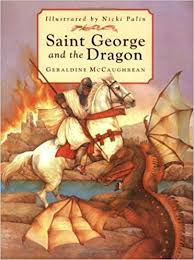St. George and the Dragon
Listen to the Recess! Clip
| Author | Kevin Shortsleeve |
| Air Date | 12/11/2002 |

St. George and the Dragon Transcript
Christmas time is a time for storytelling, and though many countries have their favorite wintertime folk tales–in England–Christmas just wouldn’t be Christmas, without the tale of St. George and the Dragon.
The Patron Saint of England, St. George was, in fact, a real person who lived in about the third century. His legends, however, such as his adventures with dragons and maidens, are an invention of the Middle Ages. Written versions of the tales of St. George, such as Caxton’s Golden Legend from 1483 and popular children’s books from the late 1700s onward, all contributed to the making of the myth. But St. George was tied to Christmas through his characterization in mummers plays, an ancient tradition that was popularized in the late 1700s. Mummers plays were performed at winter festivals, and often centered on stories of the Seven Champions of Christendom, of whom St. George was the most popular hero. Later, with more characters added, St. George pantomimes often included a cameo appearance by Father Christmas himself.
Although St. George legends have been elaborated on by authors like Kenneth Graham and filmmakers like Walt Disney, his traditional characterization in Christmas mummers plays remains popular in England, where, like other European nations, fairy tale pantomimes and masquerades are a regular part of the Christmas season.
One of the reasons the legends of St. George have remained connected with Christmas is because the tales from the mummers plays celebrates rites of fertility, death and rebirth. St. George often dies in these plays, only to be resurrected. In The Christmas Revels, a Harvard University theatre group performs the St. George tradition from North Skelton in Yorkshire.
After a verse from St. George himself, a group of sword dancers clack swords in time to the music and–in a final thrust–lock swords, forming a shape that symbolizes the sun. The swords also represent the cutting down of old so that new life can spring forth. Here then is A Verse from St. George, performed by Garret Warner and the Revels sword dancers.
“First comes Christmas
Then comes Spring
Like Winter I must die
Then to life again like Spring
Dance men!
The Sword Dance now for me.”
Sources
The Oxford Companion to Children’s Literature: “Mummers Plays,” “St. George,” “Kenneth Graham” and “The Golden Age.”
Encyclopaedia Britannica, University of Chicago, 1991 “St. George,” and “Mumming Plays.”
The Christmas Revels, Harvard University. CD (1997) and program booklet (1998).